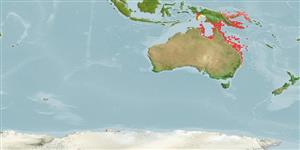Actinopterygii (ray-finned fishes) >
Clupeiformes (Herrings) >
Engraulidae (Anchovies) > Engraulinae
Etymology: Stolephorus: Greek, stole, -es = garment + Greek, pherein = to carry (Ref. 45335).
Environment / Climate / Range
Ecology
Marine; brackish; pelagic-neritic; depth range 10 - 13 m. Tropical, preferred ?; 3°S - 32°S, 134°E - 157°E (Ref. 189)
Western Pacific: Gulf of Carpentaria, southern coast of Papua New Guinea; also Moreton Bay near Brisbane, Queensland, Australia.
Size / Weight / Age
Maturity: Lm ? range ? - ? cm
Max length : 5.0 cm SL male/unsexed; (Ref. 189)
Dorsal
spines
(total): 0;
Anal
spines: 0;
Anal
soft rays: 19 - 20. Belly with 5 to 7 small needle-like pre-pelvic scutes. Maxilla tip pointed, reaching to or beyond hind border of pre-operculum, the latter concave, indented near maxilla tip. Anal fin origin far forward, below the second to sixth dorsal fin ray bases. The advanced anal fin and the presence of fine teeth on hyoid bones distinguish this species from others in the area.
Presumed coastal, pelagic and schooling. Probably tolerates lowered salinities, judging from the type locality and its occurrence in bays and inlets. Apparently not abundant. More material needed.
Life cycle and mating behavior
Maturity | Reproduction | Spawning | Eggs | Fecundity | Larvae
Whitehead, P.J.P., G.J. Nelson and T. Wongratana, 1988. FAO Species Catalogue. Vol. 7. Clupeoid fishes of the world (Suborder Clupeoidei). An annotated and illustrated catalogue of the herrings, sardines, pilchards, sprats, shads, anchovies and wolf-herrings. FAO Fish. Synop. 125(7/2):305-579. Rome: FAO. (Ref. 189)
IUCN Red List Status (Ref. 115185)
CITES (Ref. 94142)
Not Evaluated
Threat to humans
Harmless
Human uses
Fisheries: of no interest
More information
Common namesSynonymsMetabolismPredatorsEcotoxicologyReproductionMaturitySpawningFecundityEggsEgg development
ReferencesAquacultureAquaculture profileStrainsGeneticsAllele frequenciesHeritabilityDiseasesProcessingMass conversion
Tools
Special reports
Download XML
Internet sources
